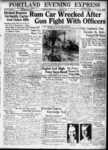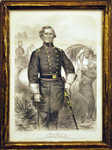Keywords: Maine Collection
- Historical Items (9974)
- Tax Records (0)
- Architecture & Landscape (1797)
- Online Exhibits (160)
- Site Pages (568)
- My Maine Stories (30)
- Lesson Plans (4)
Online Exhibits
Your results include these online exhibits. You also can view all of the site's exhibits, view a timeline of selected events in Maine History, and learn how to create your own exhibit. See featured exhibits or create your own exhibit
Exhibit
Rum, Riot, and Reform - Women Leaders and Temperance
"… Womans Christian Temperance Union Scrapbook 1898 Collections of Maine Historical Society This scrapbook of newspaper clippings and photographs…"
Exhibit
Valentines Day cards have long been a way to express feelings of romance or love for family or friends. These early Valentines Day cards suggest the ways in which the expression of those sentiments has changed over time.
Exhibit
Rum, Riot, and Reform - A Call to Temperance
"1849 Collections of Maine Historical Society On April 7, 1849 Jere Swett was indulging himself at the Exchange Street saloon of Harrison G."
Exhibit
Mainers began propagating fish to stock ponds and lakes in the mid 19th century. The state got into the business in the latter part of the century, first concentrating on Atlantic salmon, then moving into raising other species for stocking rivers, lakes, and ponds.
Exhibit
Rum, Riot, and Reform - Influential & Interesting Documents
"951, vol. 14 Public drinking establishments were regulated in Maine as early as 1636 when tavern keepers were held accountable for allowing anyone to…"
Exhibit
Hermann Kotzschmar: Portland's Musical Genius
During the second half of the 19th century, "Hermann Kotzschmar" was a familiar household name in Portland. He spent 59 years in his adopted city as a teacher, choral conductor, concert artist, and church organist.
Exhibit
Rum, Riot, and Reform - Bootleggers vs. Police
"… in Moxie cases, 1927 Seized at a Yarmouth Inn Collections of Maine Historical Society/Maine Today Media Citizens in Maine and throughout the nation…"
Exhibit
Rum, Riot, and Reform - Society Copes
"… 1930 New arrangement by Rudy Vallee (1901-1986) Collections of Maine Historical Society Written at the University of Maine, Orono by Lincoln…"
Exhibit
Evergreens and a Jolly Old Elf
Santa Claus and evergreens have been common December additions to homes, schools, businesses, and other public places to America since the mid nineteenth century. They are two symbols of the Christian holiday of Christmas whose origins are unrelated to the religious meaning of the day.
Exhibit
Shepard Cary: Lumberman, Legislator, Leader and Legend
Shepard Cary (1805-1866) was one of the leading -- and wealthiest -- residents of early Aroostook County. He was a lumberman, merchant, mill operator, and legislator.
Exhibit
Rum, Riot, and Reform - Neal Dow
"… X The Portland Herald, March 20, 1894 Collections of Maine Historical Society Pamphlet 2541 Ramrod Jubilee broadside, Portland, 1854…"
Exhibit
From French Canadians to Franco-Americans
French Canadians who emigrated to the Lewiston-Auburn area faced discrimination as children and adults -- such as living in "Little Canada" tenements and being ridiculed for speaking French -- but also adapted to their new lives and sustained many cultural traditions.
Exhibit
Rum, Riot, and Reform - Acknowledgements
"… College Library, Special Collections Burden Collection Joyce Butler The Herbert Cary Family Charles and Joanne Cochrane The First Parish in…"
Exhibit
From Sewers to Skylines: William S. Edwards's 1887 Photo Album
William S. Edwards (1830-1918) was a civil engineer who worked for the City of Portland from 1876-1906. Serving as First Assistant to Chief Engineer William A. Goodwin, then to Commissioner George N. Fernald, Edwards was a fixture in City Hall for 30 consecutive years, proving indispensable throughout the terms of 15 Mayors of Portland, including all six of those held by James Phineas Baxter. Edwards made significant contributions to Portland, was an outstanding mapmaker and planner, and his works continue to benefit historians.
Exhibit
Rum, Riot, and Reform - Drinking: Elegance and Debauchery
"Harris (active 1828-1852) pen on parchment Collections of Maine Historical Society; gift of Philip Isaacson This remarkable cartoon recalls one of…"
Exhibit
Presque Isle and the Civil War
Presque Isle had fewer than 1,000 residents in 1860, but it still felt the impact of the Civil War. About half of the town's men went off to war. Of those, a third died. The effects of the war were widespread in the small community.
Exhibit
Independence and Challenges: The Life of Hannah Pierce
Hannah Pierce (1788-1873) of West Baldwin, who remained single, was the educated daughter of a moderately wealthy landowner and businessman. She stayed at the family farm throughout her life, operating the farm and her various investments -- always in close touch with her siblings.
Exhibit
Passing the Time: Artwork by World War II German POWs
In 1944, the US Government established Camp Houlton, a prisoner of war (POW) internment camp for captured German soldiers during World War II. Many of the prisoners worked on local farms planting and harvesting potatoes. Some created artwork and handicrafts they sold or gave to camp guards. Camp Houlton processed and held about 3500 prisoners and operated until May 1946.
Exhibit
Memorializing Civil War Veterans: Portland & Westbrook
Three cemeteries -- all of which were in Westbrook during the Civil War -- contain headstones of Civil War soldiers. The inscriptions and embellishments on the stones offer insight into sentiments of the eras when the soldiers died.
Exhibit
Washington County Through Eastern's Eye
Images taken by itinerant photographers for Eastern Illustrating and Publishing Company, a real photo postcard company, provide a unique look at industry, commerce, recreation, tourism, and the communities of Washington County in the early decades of the twentieth century.
Exhibit
Student Exhibit: Bloomfield Academy
In 1842, the new Bloomfield Academy was constructed in Skowhegan. The new brick building replaced the very first Bloomfield Academy, a small wooden building that had been built in 1814 and served as the high school until 1871. After that, it housed elementary school classes until 1980.
Exhibit
Rum, Riot, and Reform - Drinking Implements
"1800 England or United States Blown glass Collections of Portland Museum of Art, Maine; bequest of Margaret Jane Mussey Sweat Discovered in the…"
Exhibit
Westbrook Seminary: Educating Women
Westbrook Seminary, built on Stevens Plain in 1831, was founded to educate young men and young women. Seminaries traditionally were a form of advanced secondary education. Westbrook Seminary served an important function in admitting women students, for whom education was less available in the early and mid nineteenth century.
Exhibit
In 1921, Guy Gannett purchased two competing Portland newspapers, merging them under the Portland Press Herald title. He followed in 1925 with the purchase the Portland Evening Express, which allowed him to combine two passions: photography and aviation.
























